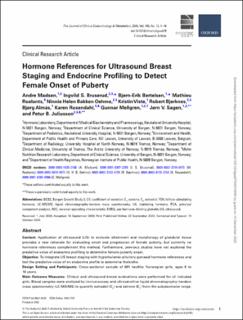| dc.contributor.author | Madsen, Andre | |
| dc.contributor.author | Bruserud, Ingvild Særvold | |
| dc.contributor.author | Bertelsen, Bjørn-Erik | |
| dc.contributor.author | Roelants, Mathieu | |
| dc.contributor.author | Oehme, Ninnie | |
| dc.contributor.author | Viste, Kristin | |
| dc.contributor.author | Bjerknes, Robert | |
| dc.contributor.author | Almås, Bjørg | |
| dc.contributor.author | Rosendahl, Karen | |
| dc.contributor.author | Mellgren, Gunnar | |
| dc.contributor.author | Sagen, Jørn V. | |
| dc.contributor.author | Juliusson, Petur Benedikt | |
| dc.date.accessioned | 2021-05-05T10:57:45Z | |
| dc.date.available | 2021-05-05T10:57:45Z | |
| dc.date.created | 2020-11-09T15:01:16Z | |
| dc.date.issued | 2020 | |
| dc.Published | Journal of Clinical Endocrinology and Metabolism. 2020, 105:dgaa679 (12), 1-10. | |
| dc.identifier.issn | 0021-972X | |
| dc.identifier.uri | https://hdl.handle.net/11250/2753660 | |
| dc.description.abstract | Context
Application of ultrasound (US) to evaluate attainment and morphology of glandular tissue provides a new rationale for evaluating onset and progression of female puberty, but currently no hormone references complement this method. Furthermore, previous studies have not explored the predictive value of endocrine profiling to determine female puberty onset.
Objective
To integrate US breast staging with hypothalamic-pituitary-gonadal hormone references and test the predictive value of an endocrine profile to determine thelarche.
Design Setting and Participants
Cross-sectional sample of 601 healthy Norwegian girls, ages 6 to 16 years.
Main Outcome Measures
Clinical and ultrasound breast evaluations were performed for all included girls. Blood samples were analyzed by immunoassay and ultrasensitive liquid chromatography–tandem mass spectrometry (LC-MS/MS) to quantify estradiol (E2) and estrone (E1) from the subpicomolar range.
Results
References for E2, E1, luteinizing hormone, follicle-stimulating hormone, and sex hormone–binding globulin were constructed in relation to chronological age, Tanner stages, and US breast stages. An endocrine profile index score derived from principal component analysis of these analytes was a better marker of puberty onset than age or any individual hormone, with receiver-operating characteristic area under the curve 0.91 (P < 0.001). Ultrasound detection of nonpalpable glandular tissue in 14 out of 264 (5.3%) girls with clinically prepubertal presentation was associated with significantly higher median serum levels of E2 (12.5 vs 4.9 pmol/L; P < 0.05) and a distinct endocrine profile (arbitrary units; P < 0.001).
Conclusions
We provide the first hormone references for use with US breast staging and demonstrate the application of endocrine profiling to improve detection of female puberty onset. | en_US |
| dc.language.iso | eng | en_US |
| dc.publisher | Oxford University Press | en_US |
| dc.rights | Navngivelse 4.0 Internasjonal | * |
| dc.rights.uri | http://creativecommons.org/licenses/by/4.0/deed.no | * |
| dc.title | Hormone references for ultrasound breast staging and endocrine profiling to detect female onset of puberty | en_US |
| dc.type | Journal article | en_US |
| dc.type | Peer reviewed | en_US |
| dc.description.version | publishedVersion | en_US |
| dc.rights.holder | Copyright 2020 The Authors | en_US |
| cristin.ispublished | true | |
| cristin.fulltext | original | |
| cristin.qualitycode | 2 | |
| dc.identifier.doi | 10.1210/clinem/dgaa679 | |
| dc.identifier.cristin | 1846232 | |
| dc.source.journal | Journal of Clinical Endocrinology and Metabolism | en_US |
| dc.source.40 | 105:dgaa679 | |
| dc.source.14 | 12 | |
| dc.source.pagenumber | e4886–e4895 | en_US |
| dc.relation.project | Helse Vest RHF: 912221 | en_US |
| dc.identifier.citation | Journal of Clinical Endocrinology and Metabolism. 2020, 105(12): e4886–e4895 | en_US |
| dc.source.volume | 105 | en_US |
| dc.source.issue | 12 | en_US |

